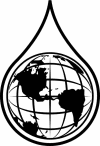Not just a drop in the bucket: expanding access to point-of-use water treatment systems
- PMID: 11574307
- PMCID: PMC1446826
- DOI: 10.2105/ajph.91.10.1565
Not just a drop in the bucket: expanding access to point-of-use water treatment systems
Abstract
Since 1990, the number of people without access to safe water sources has remained constant at approximately 1.1 billion, of whom approximately 2.2 million die of waterborne disease each year. In developing countries, population growth and migrations strain existing water and sanitary infrastructure and complicate planning and construction of new infrastructure. Providing safe water for all is a long-term goal; however, relying only on time- and resource-intensive centralized solutions such as piped, treated water will leave hundreds of millions of people without safe water far into the future. Self-sustaining, decentralized approaches to making drinking water safe, including point-of-use chemical and solar disinfection, safe water storage, and behavioral change, have been widely field-tested. These options target the most affected, enhance health, contribute to development and productivity, and merit far greater priority for rapid implementation.
Figures





Similar articles
-
Barriers and Enabling Factors Associated with the Implementation of Household Solar Water Disinfection: A Qualitative Study in Northwest Ethiopia.Am J Trop Med Hyg. 2020 Feb;102(2):458-467. doi: 10.4269/ajtmh.18-0412. Am J Trop Med Hyg. 2020. PMID: 31837131 Free PMC article.
-
Water Disinfection in Rural Areas Demands Unconventional Solar Technologies.Acc Chem Res. 2019 May 21;52(5):1187-1195. doi: 10.1021/acs.accounts.8b00578. Epub 2019 Apr 3. Acc Chem Res. 2019. PMID: 30943006
-
Providing clean water, keeping water clean: an integrated approach.Int J Environ Health Res. 2003 Jun;13 Suppl 1:S89-94. doi: 10.1080/0960312031000102840. Int J Environ Health Res. 2003. PMID: 12775384
-
The problem of drinking water access: A review of disinfection technologies with an emphasis on solar treatment methods.Chemosphere. 2019 Mar;218:1014-1030. doi: 10.1016/j.chemosphere.2018.11.205. Epub 2018 Nov 30. Chemosphere. 2019. PMID: 30609481 Review.
-
Clean Water for Developing Countries.Annu Rev Chem Biomol Eng. 2015;6:217-46. doi: 10.1146/annurev-chembioeng-061114-123432. Annu Rev Chem Biomol Eng. 2015. PMID: 26247291 Review.
Cited by
-
A stepped wedge, cluster-randomized trial of a household UV-disinfection and safe storage drinking water intervention in rural Baja California Sur, Mexico.Am J Trop Med Hyg. 2013 Aug;89(2):238-245. doi: 10.4269/ajtmh.13-0017. Epub 2013 Jun 3. Am J Trop Med Hyg. 2013. PMID: 23732255 Free PMC article. Clinical Trial.
-
A Survey of the Community Water Supply of some rural Riverine Communities in the Niger Delta region, Nigeria: Health implications and literature search for suitable interventions.Niger Med J. 2011 Jan;52(1):13-18. Niger Med J. 2011. PMID: 21968510 Free PMC article.
-
Bacterial quality of drinking water stored in containers by boat households in Hue City, Vietnam.Environ Health Prev Med. 2008 Jul;13(4):198-206. doi: 10.1007/s12199-008-0029-x. Epub 2008 Apr 22. Environ Health Prev Med. 2008. PMID: 19568906 Free PMC article.
-
Application of tools to monitor environmental conditions, identify exposures, and inform decision-making to improve infection prevention and control practices in Malawian maternity wards.Environ Monit Assess. 2020 Jan 22;192(2):134. doi: 10.1007/s10661-020-8089-5. Environ Monit Assess. 2020. PMID: 31970501
-
Muddying the waters: a new area of concern for drinking water contamination in Cameroon.Int J Environ Res Public Health. 2014 Nov 28;11(12):12454-72. doi: 10.3390/ijerph111212454. Int J Environ Res Public Health. 2014. PMID: 25464137 Free PMC article.
References
-
- Taylor P. Regional perspectives on water safety: Africa. In: Craun GF, Robinson DE, Hauchman FS, eds. Microbial Pathogens and Disinfection By-Products in Drinking Water: Health Effects and Management of Risks. Washington, DC: International Life Sciences Institute Press; 2001.
-
- World Health Organization, United Nations Children's Fund (UNICEF), Water Supply and Sanitation Council. Global Water Supply and Sanitation Assessment 2000 Report. New York, NY: UNICEF; 2000.
-
- Bradley DJ, Emurwon P. Predicting the epidemiological effect of changing water sources. East Afr Med J. 1968;45: 284–291. - PubMed
-
- Water and Sanitation. Fact Sheet Number 112. Geneva, Switzerland: World Health Organization; November 1996. Available at http://www.who.inl/inf-fs/en/factiiz.html.
-
- Urban Example—Prospective for the Future. Water Supply and Sanitation to Urban Marginal Areas of Tegucigalpa, Honduras. New York, NY: UNICEF; 1989.
Publication types
MeSH terms
LinkOut - more resources
Full Text Sources
Other Literature Sources
Medical

